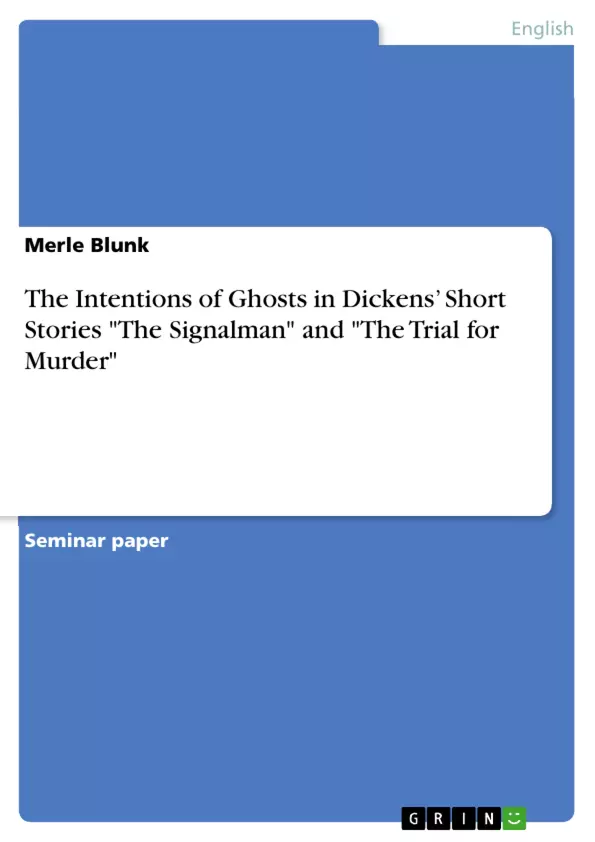Short stories dealing with gothic elements like ghost appearances in a spooky atmosphere are common for the Victorian Era. Some ghost stories entertain the reader in a surreal and scary, yet funny way. An example may be the story “The Canterville Ghost” by Oscar Wilde (Wilde 1963). As in the short story “The Haunted and the Haunters” by Edward Bulwer-Lytton (Bulwer-Lytton 1963), ghosts also constitute horror elements used to scare the reader. Hence, ghosts and their intentions differ substantially in literature varying from horror and humour to morality.
Charles Dickens is a widely read author of the nineteenth century and well known for his descriptive and gothic influenced way of writing (Mulvey-Roberts 1998). This paper concerns the question: What are the ghost’s intentions in Charles Dickens’ short stories “The Signalman” and “The Trial for Murder”?
To answer this question, the analysis begins by taking a closer look at the short story “The Signalman” which appeared as a chapter of Mugby Junction, an extra Christmas number of Dickens’ weekly journal All the Year Round in 1866 (Dickens 1997). Afterwards, the short story “The Trial for Murder” is analysed. This story appeared as a chapter of Dr Marigold’s Prescriptions, an extra Christmas number of Dickens’ weekly journal in 1865 (ibid.). Then the short stories are compared with regard to the ghost’s intentions and how they achieve their aims are comparted as the purposes of ghosts in literature are numerous.
Table of Contents
- Introduction
- "The Signalman"
- Formal analysis
- The ghost in the story
- "The Trial for Murder"
- Formal analysis
- The ghost in the story
- Comparison
- Conclusion
Objectives and Key Themes
This paper explores the intentions of ghosts in Charles Dickens' short stories "The Signalman" and "The Trial for Murder". By analyzing the formal aspects of the stories, particularly the depiction of the ghosts and their actions, the paper aims to understand the role of supernatural elements in Dickens' work.
- The nature and purpose of ghosts in Victorian literature
- The use of gothic elements in Dickens' short stories
- The relationship between the supernatural and the human world
- The significance of the railway and industrialization in the context of the stories
- Dickens' depiction of death, grief, and warning in "The Signalman"
Chapter Summaries
- Introduction: This chapter provides an overview of ghost stories in the Victorian era and introduces Charles Dickens as a key figure in this literary genre. It also establishes the research question: what are the ghosts' intentions in "The Signalman" and "The Trial for Murder"?
- "The Signalman": This chapter focuses on a detailed analysis of the short story "The Signalman". It explores the story's setting, characters, narrative structure, and the use of gothic elements. The analysis also examines the initial appearance of the ghost, its possible intentions, and the subsequent events that occur after the ghost's encounters with the signalman.
Keywords
This study focuses on the following keywords: Charles Dickens, ghost stories, Victorian literature, gothic elements, "The Signalman," "The Trial for Murder," supernatural, formal analysis, intention, warning, death, railway, industrialization.
- Quote paper
- Merle Blunk (Author), 2016, The Intentions of Ghosts in Dickens’ Short Stories "The Signalman" and "The Trial for Murder", Munich, GRIN Verlag, https://www.grin.com/document/464090



